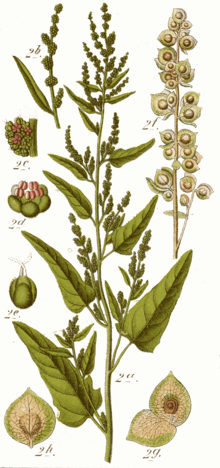| Atriplex | |
|---|---|

| |
| Garden orache (Atriplex hortensis) From Sturm & Sturm (1796): Deutschlands Flora in Abbildungen. | |
| Scientific classification | |
| Kingdom: | Plantae |
| Clade: | Tracheophytes |
| Clade: | Angiosperms |
| Clade: | Eudicots |
| Order: | Caryophyllales |
| Family: | Amaranthaceae |
| Subfamily: | Chenopodioideae |
| Tribe: | Atripliceae |
| Genus: | Atriplex L.[1] |
| Type species | |
| Atriplex hortensis L.
| |
| Species | |
| Synonyms[1] | |
|
List
| |
Atriplex (/ˈætrɪplɛks/[2]) is a plant genus of about 250 species, known by the common names of saltbush and orache (/ˈɒrɪtʃ, -ətʃ/;[3][4] also spelled orach). It belongs to the subfamily Chenopodioideae of the family Amaranthaceae s.l.. The genus is quite variable and widely distributed. It includes many desert and seashore plants and halophytes, as well as plants of moist environments. The generic name originated in Latin and was applied by Pliny the Elder to the edible oraches.[5] The name saltbush derives from the fact that the plants retain salt in their leaves; they are able to grow in areas affected by soil salination.
- ^ a b "Atriplex L." Plants of the World Online. Retrieved 19 June 2022.
- ^ Sunset Western Garden Book, 1995:606–607
- ^ "orach". The Chambers Dictionary (9th ed.). Chambers. 2003. ISBN 0-550-10105-5.
- ^ "orache". Oxford English Dictionary third edition. Oxford University Press. June 2004. Retrieved 7 December 2018.
- ^ Quattrocchi, Umberto (2000). CRC World Dictionary of Plant Names. Vol. I: A-C. CRC Press. p. 232. ISBN 978-0-8493-2675-2.